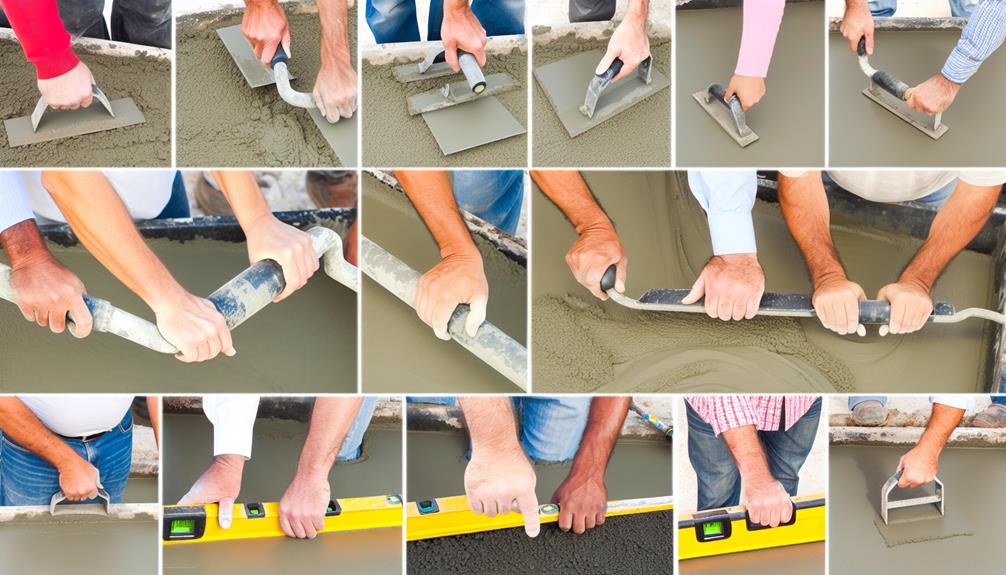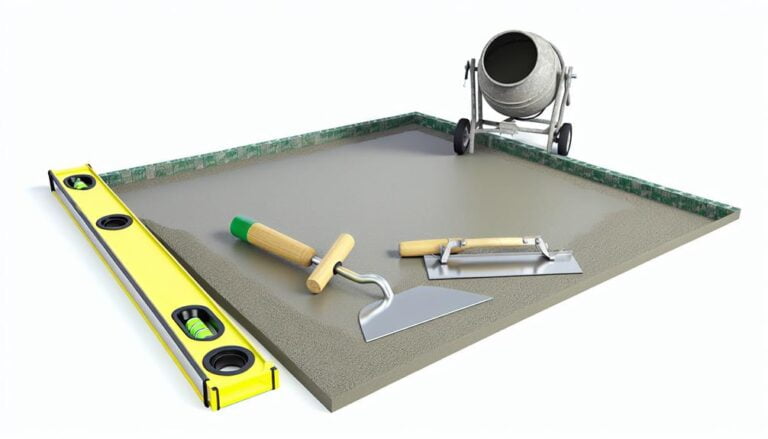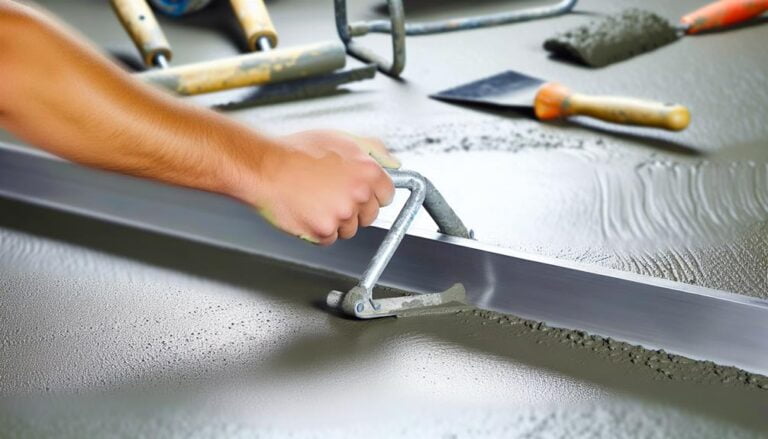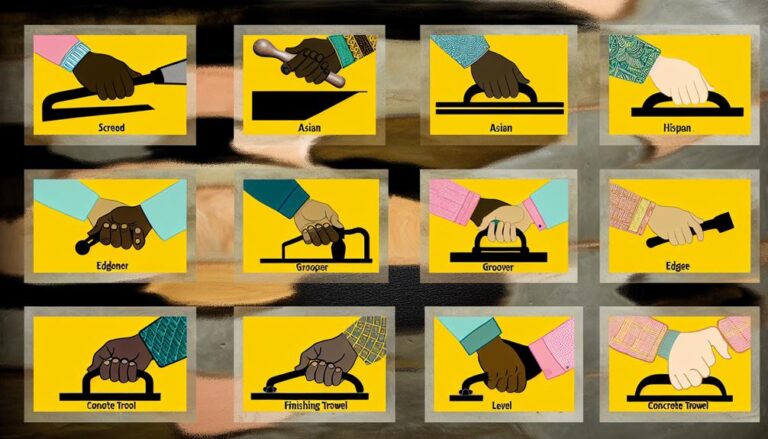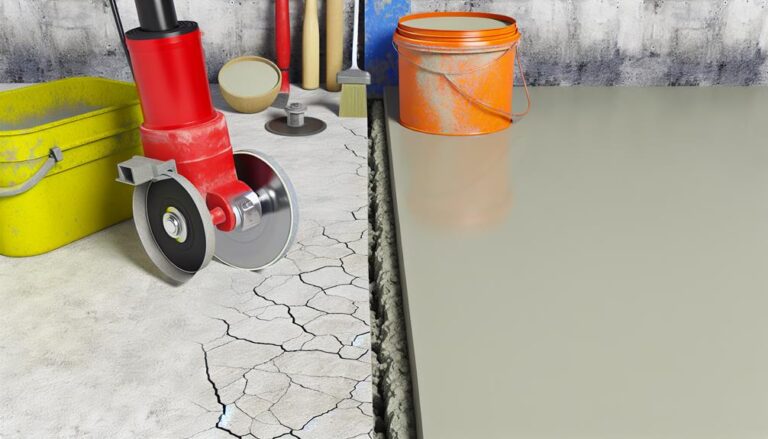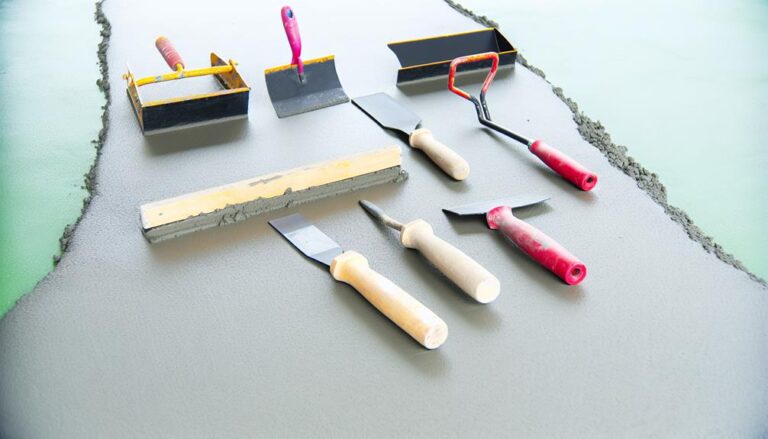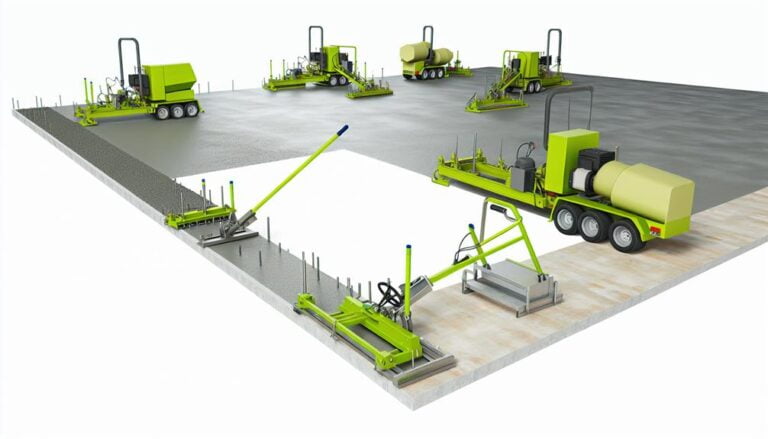What Are the Best Techniques for Concrete Leveling?
The best techniques for leveling concrete include mudjacking, polyurethane foam leveling, and slabjacking. They involve injecting a mixture or foam underneath the concrete to raise it. For smaller areas, you can use a trowel to manually apply a leveling compound. Grinding can also be useful if the concrete is severely uneven. Always remember, proper leveling is crucial to prevent safety hazards and structural damage. There's more to concrete leveling than meets the eye, so buckle up and prepare to dive deeper into this fascinating topic.
Understanding Concrete Leveling
To get your concrete looking smooth and level, it's important to first understand the process of concrete leveling. It's not as daunting as it sounds, but it does require knowledge, precision, and the right tools.
Firstly, you need to diagnose the problem. If your concrete is uneven, it may be due to soil shifting beneath it, or perhaps the concrete was poorly installed in the first place. Identifying the cause will help you decide on the most effective leveling technique.
Next, you'll need the right equipment. Typically, this includes a leveling compound, a trowel, and possibly a concrete grinder. You'll also need safety gear, like gloves and goggles, to protect yourself during the process.
The actual process of leveling involves pouring the leveling compound onto the uneven concrete and then spreading it out with a trowel. This fills in the low spots and creates a smooth, level surface. However, if the concrete is severely uneven, you might need to grind it down first.
Importance of Proper Concrete Leveling
Properly leveling your concrete isn't just about aesthetics; it's a crucial step in ensuring long-term stability and safety. Inadequately leveled concrete can lead to potential hazards, including trips and falls, water pooling, and structural damage. The importance of this task cannot be overstated.
| Reason | Problem | Solution |
|---|---|---|
| Safety | Uneven concrete can cause trips and falls. | Proper leveling eliminates such risks. |
| Water Pooling | Improperly leveled concrete can lead to water accumulation. | Leveling ensures proper drainage, preventing water-related issues. |
| Structural Integrity | Uneven concrete can cause structural damage. | Correct leveling maintains a structure's integrity. |
Mudjacking: An Old-Fashioned Technique
Mudjacking, a traditional method of concrete leveling, might sound antiquated, but it's proven its worth over the years. Don't be fooled by its old-fashioned name; mudjacking can be an effective, economical solution for your concrete leveling needs.
This technique involves drilling small holes into the uneven concrete slab. Then, a mixture of water, soil, and cement – commonly known as 'mud' or 'slurry' – is pumped into these holes. As the slurry fills up the voids beneath the slab, it lifts and levels the concrete. It's a straightforward process, but it requires skill to get it right.
You'll appreciate mudjacking for its cost-effectiveness. It's significantly less expensive than replacing the entire slab. Plus, it's typically faster, with most jobs completed in a day or less. And because the materials used are similar to the original concrete, there's no worry about color mismatch.
However, it's not without its drawbacks. The drilled holes can be noticeable, and the method doesn't address the underlying soil issues that caused the concrete to shift in the first place. But for a quick, budget-friendly fix, mudjacking often fits the bill.
Polyurethane Foam Leveling Explained
While mudjacking has its merits, there's another modern technique you may want to consider for concrete leveling: polyurethane foam leveling. This method is rapidly gaining popularity due to its numerous advantages.
Here's how it works: tiny holes are drilled into the concrete, then a specialized foam is injected underneath. As the foam expands, it lifts the concrete, leveling it in the process. It's a relatively quick procedure, often completed in just a matter of hours.
What makes this method stand out is its light weight. Unlike mudjacking, which uses a heavy, muddy slurry to raise the concrete, polyurethane foam is light. This significantly reduces the risk of further soil compression underneath the concrete, reducing the likelihood of future problems.
Additionally, polyurethane foam offers a better seal, keeping water out. This prevents erosion and damage from freezing and thawing cycles. It's also a more durable solution, with the foam maintaining its shape and strength over time.
Slabjacking: A Detailed Overview
Often overlooked, slabjacking is another effective method you can use for concrete leveling. It's a process that raises your sunken concrete slabs back to their original position. This technique comes in handy when your concrete surface starts showing signs of settling or sinking. Slabjacking doesn't require you to replace the entire concrete surface, which can be quite a cost-effective solution.
Here's how it works:
- Small holes are strategically drilled into the sunken concrete slab.
- A mixture, often made of soil, sand, cement, and water, is pumped into these holes.
- This mixture fills the void under the slab causing it to rise back to its original level.
- Once the slab is leveled, the drilled holes are filled and sealed.
Slabjacking isn't just effective, but also quick. It typically only takes a few hours to complete. It's less disruptive too, minimizing disturbance to your landscape. It's an excellent option if you're looking for an affordable, efficient method to rectify uneven concrete. However, it's crucial that you hire a professional for this job to ensure a smooth, level result. Do remember though, it's not a one-size-fits-all solution. It may not work for severe cases of sinking or unevenness.
Opting for Self-Leveling Concrete
If you're dealing with a concrete surface that's extremely uneven, you might want to consider the use of self-leveling concrete. It's a type of cement that's mixed with polymers and other additives to create a flowable, easy-to-apply mixture. This product is perfect for areas that need a quick and effortless leveling solution.
You'll find that it's user-friendly. Simply pour it onto the problem area and let gravity do its work. It naturally fills in dips and low spots, creating a smooth, level surface. It's a fantastic option if you're tackling indoor projects like leveling subfloors before installing new flooring.
But it's not all sunshine and rainbows. While self-leveling concrete is convenient, it's also more expensive than traditional concrete. And it's not the best choice for outdoor usage, as it's not as durable. You've also got to prep the area properly before application. This includes cleaning and priming the surface to ensure the mixture adheres well.
Grinding as a Concrete Leveling Technique
Another effective method for leveling concrete is grinding, a technique that involves removing the top layer of your uneven concrete surface to create a smooth, level finish. This is accomplished by using a concrete grinder, a powerful tool that uses abrasive discs to smooth and level out the concrete.
Grinding isn't only effective but also offers several additional benefits:
- Speed: Grinding is a fast process that quickly removes high spots and other irregularities.
- Precision: With grinding, you can achieve a high level of accuracy, especially on large concrete areas.
- Versatility: Grinders come in various sizes and types, making it possible to treat different types of surfaces.
- Cost-effective: Despite the need for professional expertise, grinding can be relatively inexpensive compared to other leveling techniques.
However, it's important to remember that grinding should be done by a professional. Inadequate grinding could lead to further surface irregularities, making your situation worse. So, when you're dealing with uneven concrete, grinding can be an excellent choice – just ensure it's done right.
Concrete Leveling With Plywood
While grinding is a common method, you can also use plywood for concrete leveling, a straightforward and cost-effective solution for smaller areas. You don't need advanced skills or expensive tools for this method; a piece of plywood and a little bit of patience are enough.
Start by sweeping the area to remove any debris, ensuring a clean surface. Place a plywood sheet over the concrete area needing leveling. Now, walk over the plywood, applying even pressure. It's important to maintain balance so that the pressure spreads evenly across the surface. This process helps to highlight high and low spots on the concrete surface.
Once you've identified these spots, you'll know where to apply concrete patching compound. Use a trowel to spread the compound over the low areas, filling in the gaps. When it starts to harden, place the plywood back on top and repeat the walking process. This helps to flatten and level the compound.
Though it might take a few rounds, this plywood method is an affordable and simple way to level small areas of concrete. Just remember, it's not suitable for larger spaces or heavily damaged areas, so consider a professional service in those cases.
Using Hydraulic Jacks for Leveling
Moving onto larger or more uneven surfaces, you can employ hydraulic jacks for effective concrete leveling. These jacks, powered by liquid pressure, make heavy lifting a breeze and provide a reliable method to level concrete slabs.
Firstly, you'll need to place the jacks under the concrete slab in the areas where it's uneven. You then pump the jack, causing it to raise the slab gradually until it's level. It's important to do this slowly and incrementally to prevent cracking or damage.
Here are some key things to remember when using hydraulic jacks for leveling:
- Ensure the jack is on solid ground; it needs a firm base to operate correctly.
- Always use the right size jack for the weight of the slab; overloading can result in equipment failure.
- Monitor the jack's pressure gauge to prevent over-pumping.
- Use multiple jacks for larger slabs to distribute the weight evenly.
Digital Tools for Concrete Leveling
In the realm of concrete leveling, digital tools offer precision and ease that can significantly enhance your work. These tools, such as digital levels and laser levels, can provide you with exact measurements, reducing the risk of human error.
Digital levels, for instance, give you readouts in degrees, percent, or inches/feet, eliminating the guesswork from your leveling tasks. They're easy to use, too. Simply place it on the surface and read the digital display.
Another popular tool is the laser level. This device projects a beam of light onto the surface, indicating a straight line. It's incredibly accurate, ensuring your concrete is perfectly level. Some models even have self-leveling capabilities, making your job even easier.
Then there's the smartphone apps like 'Bubble Level' which turn your phone into a convenient leveling tool. These apps use the phone's built-in sensors to determine level and plumb.
Frequently Asked Questions
What Is the Average Cost of Professional Concrete Leveling Services?
You're curious about the average cost of professional concrete leveling services. It's not a straightforward answer because it can vary widely based on the size and condition of the area.
However, you can generally expect to pay between $500 and $1,500. Remember, you're paying for expertise and efficiency, so it's often worth the investment.
Always get multiple quotes and check the contractor's reputation before making a decision.
How Long Does It Typically Take to Level a Concrete Surface?
The time it takes to level a concrete surface can vary. It'll depend on the size and condition of the area, and the method used. Typically, it might take a few hours to a full day. For larger, more complex jobs, it could extend to several days.
Are There Any Environmentally Friendly Options for Concrete Leveling?
Yes, there are eco-friendly options for concrete leveling. You might consider mudjacking, which uses a slurry of water, soil, and cement. It's less resource-intensive than other methods, reuses existing materials, and doesn't involve harmful chemicals.
Another option's using a foam made from recycled materials. Remember, while these methods are greener, they may not be suitable for all projects.
Always consider the specific needs and constraints of your project before deciding on a leveling technique.
What Are the Potential Risks or Dangers Associated With DIY Concrete Leveling?
Imagine trying to bake without knowing the recipe. That's what DIY concrete leveling can be like. You're risking uneven surfaces, structural instability, even potential injury if you're not careful.
It's not just about pouring and smoothing concrete. There's a science to it, with specific mixtures and proper leveling techniques. Without the right knowledge and tools, you could end up with more problems than you started with.
It's best to leave it to the professionals.
Can Concrete Leveling Be Done in Any Weather Conditions, or Are There Optimal Conditions for This Process?
You can't perform concrete leveling in any weather. Optimal conditions are dry and mild temperatures. If it's too cold, the concrete may not set properly. If it's too hot, it can dry out too quickly and crack. Rain can weaken the mixture and compromise the leveling.
Conclusion
You've explored the best techniques for concrete leveling, from traditional mudjacking to modern polyurethane foam and digital tools.
Remember, a startling 50% of concrete repairs fail due to poor leveling. So, whether you're opting for grinding, slabjacking, or using hydraulic jacks, ensure it's done right.
Even a simple plywood can make a difference. The key is to understand and pick the method that suits your needs the best.
Happy leveling!
